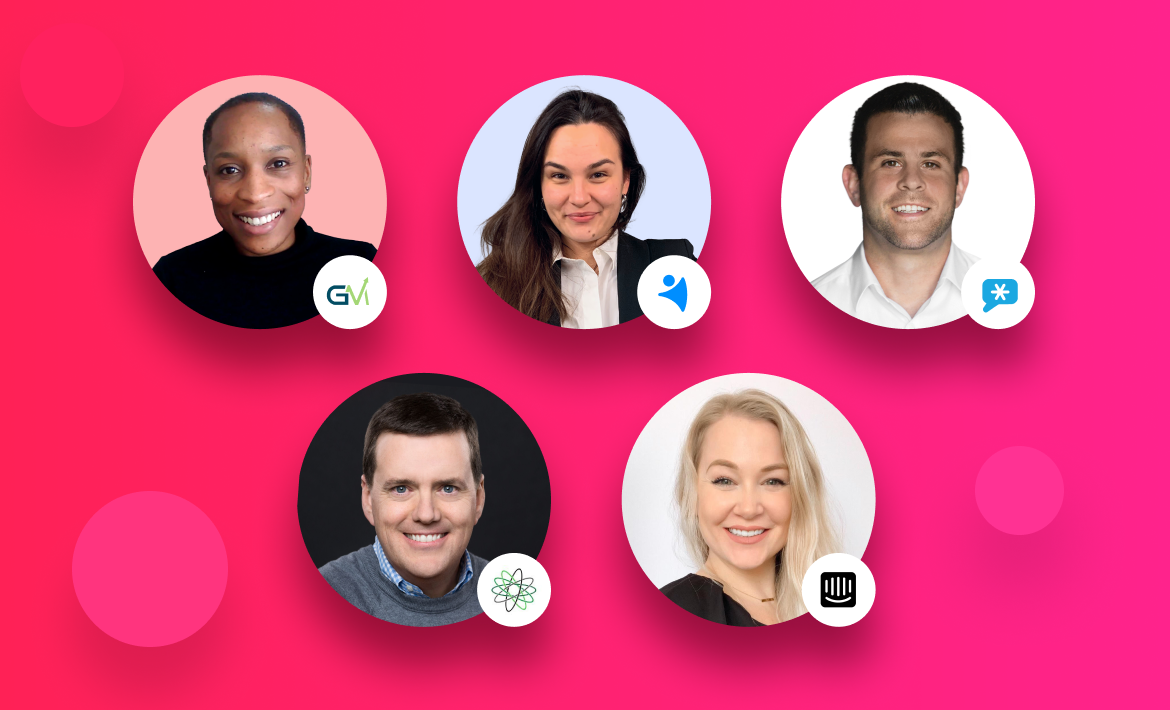Are you a salesperson? Struggling to create nurturing sequences to fill the top of the sales pipeline and convert leads? Well, you came to the right place!
For this article, we brought together five sales rock stars. They shared their advice on how to strengthen sales sequences and offered tips on what salespeople should avoid in doing so.
The same eternal questions still ring in the ears of SDRs and salespeople who deal with both hand-raisers and cold leads. How can I catch the attention of a prospect? How can I reduce the sales cycle? How can I close more deals more quickly? How can I achieve balanced content?
These never stop optimising their outreach sales sequences and content. They’re always adding new communication channels and applying creativity to reach and convert their target buyers.
Let’s dive in and study outbound sales tactics, shared by experts who succeeded with this. Any expert’s advice is worth thousands of lines of theoretical articles.

Jeff Kirchick
Vice President, Enterprise Sales @Next CallerJeff has had unparalleled sales success for over a decade and enjoys the opportunity to help mentor and coach younger sales professionals looking to get their start. He is a big believer in saying what you have to say whether it is going to be popular or not.
— What advice would you give to a salesperson trying to strengthen their prospecting sequence?
Be yourself. And hopefully that means being your authentically weird self.
Look, we are all weird in our own ways. I don't even know what it means to be 'normal'; it is a completely subjective term. We all have a unique story to tell and we all have specific values that guide our lives. We are naturally attracted to other people who share those values. So a great way to strengthen your prospecting sequence is by trying to understand ways in which you can relate to other people in terms of your values.
I'll tell you what this looks like in practice. Many years ago, I set up a Twitter account for my cat, Zoe. "Zoe" would tweet all sorts of funny things and it was mostly a little joke for me and my friends. Anyway, "Zoe" once had this really funny Twitter exchange with American Airlines. So when the time came for me to prospect American Airlines, I wrote a subject line, "American Airlines Tweets With My Cat." Think about it, if you are the recipient of that email, is there any way you can ignore that kind of subject line? Probably, not.
You are getting bombarded with sales emails all day that are all following some sort of formula or sales training program, but then out of the blue you get this thing about a cat and the airline. That sticks out like a sore thumb. The email was about the funny exchange and I segued into how it was evident to me how much they cared about customer experience based on it. Since I sell a Customer Experience product, it was a great transition into why I was reaching out to them.
And that leads to one final point – lead with "why". You need a good excuse to reach out to people. You are interrupting their day. You would never walk up to a complete stranger, interrupt their day, and ask for directions. At bare minimum you would apologize and explain why you need their help. Treat your customer no differently and do not be presumptuous about their desire to read your email. Lead off with your excuse, which is really a "why." Whether your "why" has to do with a tweeting cat, a shared interest in mentorship, or a link to a favorite sports team, ideally it ties to some shared value that helps the other person feel comfortable trusting you.
— How many touch points should a sales person apply before giving up?
I'm sure sales pundits will disagree with me, but I say never give up. Even customers who are very engaged with me oftentimes go dark for months at a time. I sell enterprise software and my customers sometimes get pulled into big projects for long periods of time where they really cannot afford to be distracted. What I am trying to get at here is that you often end up with very well-intended people who ignore you simply because it just is not the right time. Chances are, if you do get someone to respond to you, it is because you got to them at just the right time. It is not necessarily always about whether or not there is a logical fit all the time.
I might be shifting some onus on to the customer here, but realistically, unless someone tells you "no," they have not told you "no"! For all you know, you are hitting a spam filter. Or maybe they don't really check LinkedIn. Or maybe they do but they read your message when they were really busy.
Either way, you don't know they aren't interested until they say so. And what I often like to do is actually invite a customer to say "no." For one thing, it shows them that you are a human being and not a pushy sales weasel with a quota. But it also softens the entire interaction. You actually want to hear "no" if they are not interested: it allows both sides to move on and stop wasting time writing or receiving emails that amount to nothing.
— Can you share any common or major mistakes that need to be avoided along a prospecting sequence?
A lot of times, sales reps will use some sort of catchy opener (or "excuse", as I refer to it earlier), but then move directly into their sales pitch afterward. It makes the entire opening sequence seem disingenuous, because it's like you're trying to use this catchy thing to get someone's attention, but then you abandon it altogether to sell a product.
You want the opener and the value proposition to be related. For example, a sales rep once contacted me with a catchy opener about my favorite hockey team, The Boston Bruins. What made her e-mail great though was that she transitioned into her value proposition by using the same hockey terminology and drawing an analogy between hockey teams and sales teams. It made everything flow very nicely and it showed a higher level of thoughtfulness.
We also need to get out of presumptuous behaviors. Phrases like, "If you care about growing revenue, you will want to meet with us" or "When is a good time for you next week?" are good examples. In the first case, it's a little manipulative, because two things can be true at once: your buyer can be interested in whatever outcomes your product provides, and they can also think your product will not get them there.
So stop assuming you have something they need. And yes, even something as subtle as asking "when" is a good time can irritate people. It assumes they want to meet with you, and you just interrupted their day with a cold pitch. Be humble. I run in the other direction and give the customer an out. I tell them it's OK if they say "no." This makes me more approachable and it has been shown to improve results.

Samantha Gallagher
Sales Development Manager @IntercomSamantha is a Sales Development Manager at Intercom. Samantha loves connecting with new people and building powerful teams. She is a result-driven person, having a passion for developing trusted, loyal relationships with clients.
— What advice would you give to a salesperson trying to strengthen their prospecting sequence?
My advice would be to understand that there is no perfect cadence. No salesperson is closing 100% of their pipeline. Having said that, we can always work to improve and strengthen our sequence to be able to work smarter.
First and foremost, understand why you are taking each step, whether it be a phone call or follow-up email. Have an understanding of why you are going in the order that you are and why you are reaching out after a certain amount of time. If you are just blindly plugging in names and crossing your fingers, you are not going to have a lot of success.
Second, take the time to do some A/B testing. Do not get stuck on having the same sequence for every company/industry/time of year. Play around with different orders, timelines, and avenues of reaching out. Based on open rates, responses and engagement from your prospects, you'll quickly learn where to focus more of your time and energy.
Lastly, be organized. Know when to remove a prospect from your cadence, and when to add in new accounts. It is important to have fresh accounts regularly opened.
— How many touch points should a sales person apply before giving up?
There needs to be enough frequency to build familiarity. However, you need to find the sweet spot of not spamming them, and not reaching out too far apart from your last attempt where you blend in.
I believe in being persistent and working the account until they give a hard "no" and are genuinely not interested. I start by emailing a few times each week, with sprinkled in phone calls, and utilizing social platforms, like LinkedIn, to humanize myself.
If you aren't getting through on the phone, and your emails aren't being opened, then you need to course correct and make sure you have the right contact/content. Having said that, we do not have the bandwidth to work every account forever, so we need to prioritize specific accounts that will be worth the effort and time we put into it. The rest is a judgement call.
— Can you share any common or major mistakes that need to be avoided along a prospecting sequence?
I think what we see far too often is spamming prospects without bringing value. We need to bring something special to the table to show them that we could be a solution to the pain they are experiencing and have the proof to back it up.
Another mistake I see is sales people will come in hot talking about their company and all the bells and whistles without learning anything about the prospect or their company. Do not assume there is pain for an individual/company, do not assume now is a good time and do not assume our business, or their business will be a good fit. Learn to listen and be consultative.

Hannah Akijawo
Director and Founder @Growth ModeHannah started out in technology sales 12 years ago, having moved up through the ranks from a BDR through to early management. Hannah is an advocate for diversity in sales and extremely passionate about helping sales reps to increase their chances of ultimate success in their sales careers. When Hannah is not obsessing about sales processes in the remote world, she’s busy chasing my 3 year old son around the garden or pretending to be a robot that's taking over the Paw Patrol kingdom.
— What advice would you give to a salesperson trying to strengthen their prospecting sequence?
Salespeople need to know what their objectives are when creating their prospecting sequence. Here's a few questions a salesperson might ask themselves when building a sequence.
What is the desired outcome that I am seeking from each stage of the interaction? Do I want to book a call in, do I want to schedule a demo, or do I want them to read or review something?
Think about what's in it for the buyer. They are taking their time. One minute, 10 minutes, 30 minutes, or however long it may be to direct attention to your content, calls, emails, or messages. In order to keep that attention, they need to be able to quickly decipher what they are getting out of each interaction. To do this effectively, salespeople should work with marketing and wider enablement functions, keeping on the pulse what's important for their ideal customer profiles. In doing so, they increase their chances of meeting their objectives.
Be vulnerable; yes, vulnerable. We need to admit that we do not know everything, but we are open to understanding, listening, and are keen to help. This is what helps us be more human and connect on a deeper level. When prospecting, we want our prospects to understand that there is an "out". They must understand that we only have good intentions, that we are connecting with them because we have done the research and found have success with others like them.
Someone I consider to be a mentor, Cherilynn Castleman said in her book , "What's in the CARDS" talks about blurring the lines between personal and business in the post-covid world. Buyers receive more messages, emails, and connections than ever before. Companies invest more in digital engagement and most prospects have become less responsive, according to research from Gartner.
Reaching out to prospects and sharing your real-time reality is both endearing and humanises your interaction. For example, for me right now, writing this content, I'm making stars out of Play Doh with my son, playing race cars with his Paw Patrol remote control car. That is my reality. It's relatable and it gives your prospect permission to break through the business noise and engage with you in the same personal way.
— How many touch points should a sales person apply before giving up?
It takes anything from 13-18 touches to get a response from a prospect. That doesn’t mean you send 18 “just touching base”, “just checking in" emails and then give up. Salespeople should be multi-threading outreach by speaking to multiple departments and contacts. Be open about different interactions to raise credibility, as it shows a deeper level of research has gone into identifying a "prospect."
There isn't a magic number here. I've sent one message on Linkedin, had a face-to-face meeting, identified an opportunity, and entered a sales engagement. For others, I've tried 5-6 attempts to get that first response. If you are getting no response whatsoever, work with marketing to nurture prospects and wait until they raise their hand.
— Can you share any common or major mistakes that need to be avoided along a prospecting sequence?
I see 2 things everyday.
1. Salespeople sharing a massive pitch in their first email outreach message. I am highly unlikely to read your pitch even if it's EXACTLY what I need right now, because I don’t know who you are and you've assumed that I am interested in what you have to say.
2. Asking for something from me (usually time - up to an hour) without establishing any form of connection with me beforehand. Initial interactions with prospects should aim to:
- Be directly relevant. You've seen something online, spoken to someone, identified something that you know affects them. A change in law for example or manual efforts to achieve a particular task
- Be indirectly relevant. Based on social proof or trends, themes, and insights, your business is well-placed to support a foreseeable issue, challenge, or opportunity
- Provide a feeling of betterment. Give prospects something that may not have had before; something tangible... "I notice you were doing X and saw this, Y, [insert your info] as something that could be useful...".
- Ask permission to engage in further sharing of ideas, insights, time, and discussion.
We are operating in very different times, meaning we must change how we go about doing things to get different, better results.

David Dulany
Founder and CEO @TenboundDavid is a Founder and CEO of Tenbound, a research and advisory firm focused and dedicated 100% on Sales Development. Tenbound has become the hub of the Sales Development industry, with a thriving online research center, market map, tool directory, training and consulting programs and The Tenbound Sales Development Conferences, held yearly around the world.
— What advice would you give to a salesperson trying to strengthen their prospecting sequence?
Start with your buyer. Get into their world by attending the webinars they attend, listening to the podcasts they listen to, joining the online communities they participate in. Get to know their pain points and the vocabulary they use to discuss those. Talk to them in a genuine way about what they are dealing with on a daily basis that drives them crazy. Then, make all your messaging about those pain points and the way you solve them. Give them proof you can help.
— How many touch points should a sales person apply before giving up?
The only way to tell is start experimenting and track the results over a long enough time period to make it meaningful. Much of our work at Tenbound comes down to project management; setting up the A/B tests, launching, monitoring and making course corrections based on the data. Unfortunately, there are no shortcuts or tricks, it's just hard work to nail messaging.
— Can you share any common or major mistakes that need to be avoided along a prospecting sequence?
Main mistake we see if thinking you can just blast out a message to thousands of people and hope something resonates. This may work with promoting a big event or a specific offer, but trying to do this to a high value prospect will lead to either them ignoring you or marking you as spam. Again, there's no push button Easy Button in doing this. You have to study your market, learn the vocabulary, learn the pain points, put it in your messages, and consistently experiment.

Anastasia Tatsenko
Head of Customer Success @NetHunt CRMAnastasia is a chief customer carer and passionate product preacher! Her specialities include competitor analysis, sales operations, and partner negotiations. Anastasia is the one who has a "high-level view" of the entire customer success processes.
— What advice would you give to a salesperson trying to strengthen their prospecting sequence?
- Don’t pitch your product during the first interaction with the buyer. This would be something similar to texting your classmate who you’ve not spoken to since graduation in ‘09, asking for a discount at the shop he’s working for.
- Create value-based, personalized content around the pain points and challenges of a customer. When I say personalization, it’s not simply putting the recipient’s name into the subject line and body of your email. Think about the insights and context of how your product or service can help that exact person; address this in your pitch.
- Think twice on the conclusions and CTAs that you use in emails. From time-to-time, I receive well-crafted emails. However, after reading them, I get that feeling of so what? What do you want me to do with this?.
- Use a multi-channel approach. To my mind, it’s wrong to only use email or phone calls to reach out to a person. Add a mix of channels to your sequence. For example, LinkedIn is a good starting point to silhouette yourself on the horizon of a potential customer.
— How many touch points should a sales person apply before giving up?
There’s no right answer to this question. It depends on your target audience and industry specifics. There are so many different opinions on the number of necessary touchpoints. Who knows? I think that the truth is somewhere in between, 10-12 touches is okay. I also believe that it is not necessarily true that a potential buyer should hear only from the sales team when making a purchasing decision. It has to be the combination of both sales and marketing activities, aligned. Again, a multi-channel approach, as mentioned in the previous answer.
— Can you share any common or major mistakes that need to be avoided along a prospecting sequence?
From my perspective, one of the major mistakes is a product-centric pitch. Instead, focus on the problems that buyers have without underestimating their merits or achievements. Show that they can achieve more in their jobs-to-be-done list when using your product.
Another mistake is having a sequence of absolutely unrelated emails compared to other ones you send. Create a narrative, develop a list of necessary enablements, and fit them naturally into your story.
If you’re lucky enough to be in a position to hold a demo of your product, try not to show and sell the entire functionality of the product if a person doesn’t need it. Also, potential buyers won’t remember all the buttons on all the menus in your system, but they will remember stories you tell them about results they can achieve using particular features. To this end, use real-life scenarios on demo calls.
We want to extend our thanks to all the experts who dedicated their time and shared their thoughts with our community. In the process, we gained a bunch of valuable tips to try out, and a number of mistakes to avoid while sending sales pitches to potential buyers. Real-world tips and insights are good drivers of change, motivation, and inspiration.
So with that, good luck in developing an in-depth understanding of your buyers, well-crafted pitches, a steady sequence of necessary touches, a proper combination of sales channels, and lots of positive answers to buy your product! Don’t get upset if you don’t get a reply while sending your first sequence, you’ve already done the hard work in making your name ring a bell.
Now get out there and smash it!
Table of Contents
Crack the sales formula with CRM Lab
Twice a month, receive actionable CRM content to your inbox.


